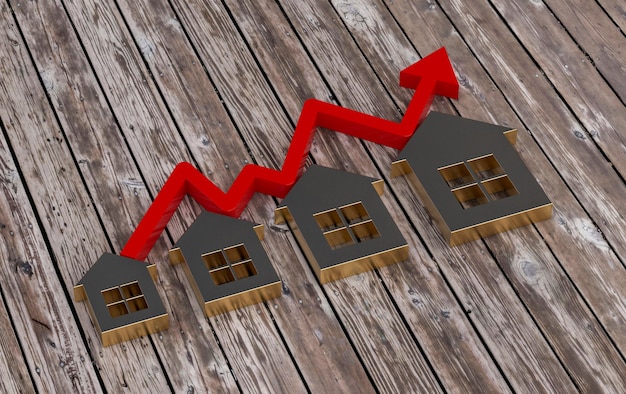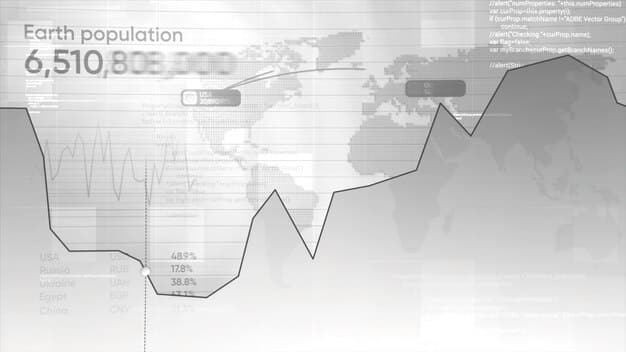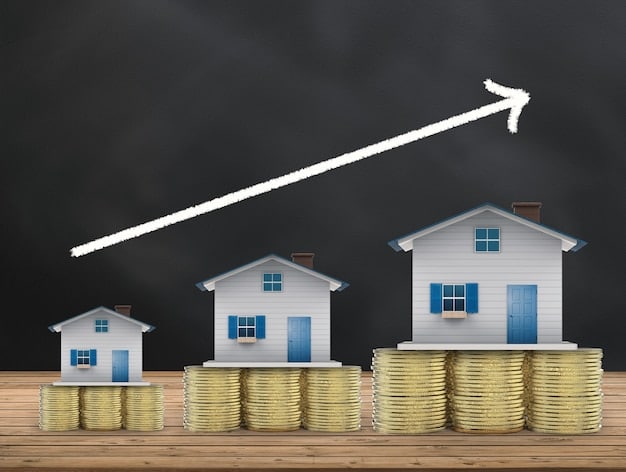What a 7.25% Federal Funds Rate Means for Your 2025 Mortgage

A projected 7.25% federal funds rate could significantly impact 2025 mortgages, potentially leading to higher interest rates and affecting affordability for homebuyers, while also influencing the broader economic landscape and investment strategies.
Navigating the complexities of the mortgage market can be daunting, especially when considering future economic forecasts. Let’s explore what the new 7.25% federal funds rate means for your 2025 mortgage and how it could affect your home-buying plans.
Understanding the Federal Funds Rate
The federal funds rate is a crucial benchmark in the U.S. economy. It influences everything from the interest rates on credit cards to the yields on government bonds. Understanding its mechanics is essential to grasping its potential effects on mortgage rates.
What is the Federal Funds Rate?
The federal funds rate is the target interest rate set by the Federal Open Market Committee (FOMC). Banks charge each other for the overnight lending of reserves. This rate serves as a foundation for many other interest rates throughout the economy.
How Does the Fed Funds Rate Work?
The Federal Reserve uses the federal funds rate to manage inflation and promote economic stability. By raising the rate, the Fed aims to cool down an overheating economy. Lowering the rate is designed to stimulate economic growth during recessions.
- Inflation Control: Higher rates can curb inflation by making borrowing more expensive.
- Economic Stimulation: Lower rates encourage spending and investment.
- Market Influence: Impacts various sectors including housing.
Understanding the basics of the federal funds rate provides essential context. Knowing how it operates and its intended purpose helps individuals anticipate how it might influence their financial decisions, particularly in the housing market.

The Forecast: A 7.25% Federal Funds Rate in 2025
Predicting the future is never easy, but economic forecasts provide valuable insights. A projected federal funds rate of 7.25% in 2025 carries significant implications for the mortgage market and broader economy. Understanding the potential reasons behind this forecast is crucial.
Factors Influencing the Forecast
Several factors might lead to a 7.25% federal funds rate. Persistent inflation, strong economic growth, or a combination of both could prompt the Federal Reserve to adopt a more hawkish stance.
Expert Opinions on the Rate Hike
Economists have varied perspectives on the likelihood and the impact of such a rate hike. Some believe it is necessary to combat inflation, while others warn it could trigger a recession. Analyzing these insights is vital for a comprehensive understanding.
- Inflationary Pressures: May signal continued high inflation rates.
- Economic Growth: Could indicate a robust economy needing moderation.
- Potential Risks: Includes risks of economic slowdown or recession.
Analyzing these forecasts is essential, even if they’re subject to change. Being aware of the potential for a 7.25% federal funds rate in 2025 enables homebuyers and investors to prepare and adjust their strategies accordingly.
Impact on Mortgage Rates
The federal funds rate has a direct and significant impact on mortgage rates. When the Fed raises the federal funds rate, mortgage rates typically follow suit. Understanding this relationship is crucial for potential homebuyers.
Direct Correlation Between Fed Rate and Mortgage Rates
Mortgage rates are closely tied to the 10-year Treasury yield, which is, in turn, influenced by the federal funds rate. As the Fed increases the federal funds rate, borrowing costs for banks rise. They typically pass those increased costs onto consumers.
How Much Could Mortgage Rates Rise?
A 7.25% federal funds rate could push mortgage rates to levels not seen in years. The exact increase will depend on various market conditions, including investor sentiment. Potential homebuyers need to prepare for potentially higher borrowing costs.

- Increased Borrowing Costs: Higher mortgage rates mean larger monthly payments.
- Home Affordability: Reduced affordability for potential homebuyers.
- Market Slowdown: Possible cooling of the housing market.
Being aware of these effects helps potential homebuyers, sellers, and investors prepare for the adjustments needed in their financial strategies.
Effects on Home Affordability
Home affordability is a significant concern for many Americans. A 7.25% federal funds rate and its resulting impact on mortgage rates inevitably lead to decreased affordability. Understanding the scope of these effects is essential for prospective homeowners.
Higher Monthly Payments
As mortgage rates increase, monthly payments rise proportionally. This can strain household budgets and make it more challenging for families to qualify for a mortgage. Analyzing the impact on monthly finances is crucial.
Impact on Qualifying for a Mortgage
Lenders consider debt-to-income ratios when approving mortgage applications. Higher mortgage rates increase these ratios, potentially disqualifying some borrowers. Potential homebuyers need to assess their financial readiness carefully.
Regional Differences in Affordability
The impact on affordability will vary regionally. Markets with already high home prices will feel the effects more acutely than those with lower costs of living. Tailoring expectations to local market conditions is critical.
Being aware of these challenges helps prospective homeowners plan accordingly. Strategies such as saving for a larger down payment, improving credit scores, or considering smaller homes can mitigate the impact of higher rates.
Strategies for Homebuyers in 2025
Despite the potential challenges, buying a home in 2025 is still achievable. Implementing effective strategies can help homebuyers navigate a higher interest rate environment. Being prepared is key to success.
Consider an Adjustable-Rate Mortgage (ARM)
ARMs typically offer lower initial interest rates compared to fixed-rate mortgages. However, they come with the risk of rate adjustments. Weighing the pros and cons carefully is crucial.
Shop Around for the Best Rates
Mortgage rates can vary significantly between lenders. Shopping around and comparing offers can save you thousands of dollars over the life of the loan. Taking the time to explore different options is worth the effort.
Improve Your Credit Score
A higher credit score can qualify you for lower interest rates. Taking steps to improve your credit score, such as paying down debt and correcting errors on your credit report, can make a significant difference.
- Down Payment: Saving for a larger down payment reduces the loan amount.
- Smaller Home: Considering a smaller or less expensive property broadens options.
- Financial Planning: Creating a budget and sticking to it is essential.
Employing these strategies requires diligence and informed decision-making. Doing so can increase their chances of securing a home that fits their financial situation.
Broader Economic Implications
The federal funds rate impacts more than just mortgage rates. Its effects ripple through the broader economy, influencing business investments, consumer spending, and overall economic growth. Understanding these broader implications is crucial.
Impact on Business Investment
Higher interest rates make borrowing more expensive for businesses. This can lead to reduced investment in new projects, equipment, and hiring. Understanding these potential limitations is crucial for business planning.
Effects on Consumer Spending
Increased borrowing costs can also curb consumer spending. Consumers may postpone large purchases, such as cars and appliances, impacting retail sales. The impact on consumer behavior needs to be considered.
Potential for Economic Slowdown
Aggressive rate hikes can potentially trigger an economic slowdown or even a recession. The Federal Reserve must carefully balance its efforts to control inflation with the risk of harming economic growth. Economic forecasting remains essential.
These broader economic impacts underscore the pervasive influence of the federal funds rate. Being aware of these larger trends provides a more comprehensive understanding of the financial landscape.
| Key Point | Brief Description |
|---|---|
| 📈 Fed Rate Impact | 7.25% rate could raise mortgage rates significantly. |
| 🏠 Affordability | Home affordability will likely decrease with higher rates. |
| 💰 Strategies | Consider ARMs and shop for the best mortgage rates. |
| 🌍 Econ. Impact | Affects business investment and consumer spending. |
FAQ
▼
The federal funds rate influences the broader interest rate environment. When the Fed raises the federal funds rate, mortgage rates typically increase because borrowing becomes more expensive for banks, who pass those costs to consumers.
▼
Homebuyers can improve their credit score, save for a larger down payment, and shop around for the best mortgage rates. Considering adjustable-rate mortgages or smaller homes can also make homeownership more affordable.
▼
While aggressive rate hikes can slow economic growth, whether it leads to a recession depends on many factors. The Fed aims to balance inflation control with maintaining economic stability. Timing and additional economic conditions could avoid a recession.
▼
High inflation often prompts the Federal Reserve to raise the federal funds rate to cool down the economy. Higher rates make borrowing more expensive, which can reduce consumer spending and investment, thereby lowering inflationary pressures.
▼
An ARM has an initial fixed-rate period followed by rates that adjust periodically based on a benchmark index. ARMs can be risky if interest rates rise significantly after the fixed-rate period, leading to higher monthly payments.
Conclusion
Understanding what the new 7.25% federal funds rate means for your 2025 mortgage—and its potential impact on mortgage rates, home affordability, and the broader economy—is critical for making informed financial decisions. By staying informed, planning strategically, and adapting to changing market conditions, potential homebuyers can still achieve their dreams of homeownership in 2025.





